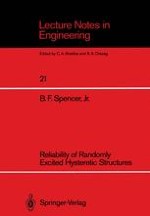1986 | OriginalPaper | Chapter
Numerical Solution of the First Passage Problem
Author : B. F. Spencer Jr.
Published in: Reliability of Randomly Excited Hysteretic Structures
Publisher: Springer Berlin Heidelberg
Included in: Professional Book Archive
Activate our intelligent search to find suitable subject content or patents.
Select sections of text to find matching patents with Artificial Intelligence. powered by
Select sections of text to find additional relevant content using AI-assisted search. powered by
Consider the general form of the three-dimensional convection-diffusion equation given by $${\partial \over {\partial x}}{k_x}{{\partial \psi } \over {\partial x}} + {\partial \over {\partial y}}{k_y}{{\partial \psi } \over {\partial y}} + {\partial \over {\partial z}} - {u_x}{{\partial \psi } \over {\partial z}} - {u_y}{{\partial \psi } \over {\partial y}} - {u_z}{{\partial \psi } \over {\partial z}} + c{{\partial \psi } \over {\partial t}} + Q = 0$$ (3.1) where kx/C, ky/C and kz/C are the diffusion coefficients; ux/C, uy/C and uz/C are the velocities; Q/C is the source term; and the boundary conditions are appropriately defined. The nonlinear partial differential equations developed in Chapter II which govern the first passage behavior of the simple hysteretic oscillator are degenerate forms of Equation 3.1. The nature of Equation 3.1 for many engineering problems gives little hope for analytical solution; thus numerical methods must be adopted to solve the problem.
